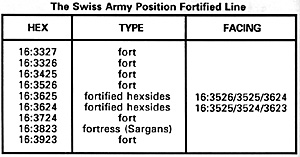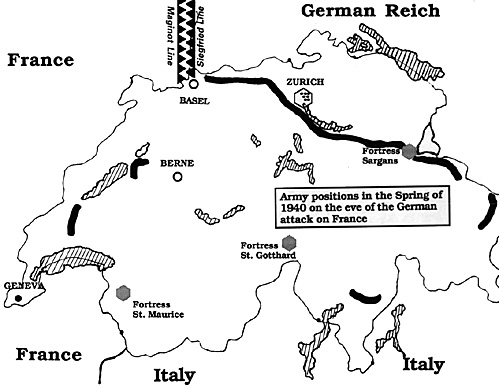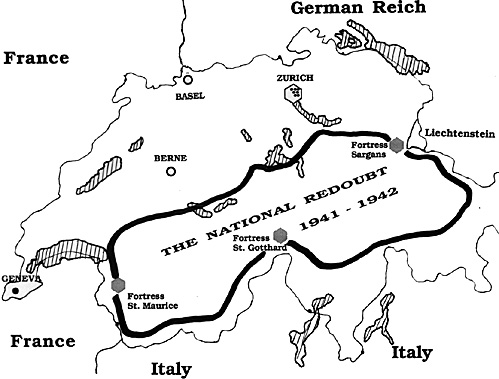 There are a number of good books
and articles dealing with the role of
Switzerland in World War Two. Most
are by prominent Swiss who held
positions of power during this time,
including military leaders and
politicians; however, there are also
several quite good French sources.
There are a number of good books
and articles dealing with the role of
Switzerland in World War Two. Most
are by prominent Swiss who held
positions of power during this time,
including military leaders and
politicians; however, there are also
several quite good French sources.
Although much of this material concentrates on how Switzerland managed to survive without being invaded by Germany (some say they collaborated), I also discovered that many preparations were made by the Swiss for defense of their country against a potential German invasion. These preparations took the form of a rather extensive series of fortifications and three fortresses. When comparing this information to the Swiss setup in Fall of France, one finds that these forts are, for the most part, not represented in the game.
For the tinkerers out there, let's take a look at these Swiss fortifications and how they might be represented in Europa terms.
Fortresses
There were three major fortress complexes built in Switzerland. One of the three was added to Europa in the errata sheet for Fall of France dated 9/9/81. This item, Fortress Sargans, is listed in the errata as a printed fortress located in hex 16:3823. This was recently reconfirmed in the Europa Almanac. However, the other two very important fortresses located in southern Switzerland are missing entirely: Fortress St. Gotthard in hex 16:3827 and Fortress St. Maurice in hex 16:3732. These should also rate as printed fortresses.
Their main purpose was to protect the rail lines and roads from any invasion from the south coming from Italy and, if necessary, blow these up to keep the enemy from using them to gain access to the interior of Switzerland. On the reverse side, any invasion coming from the north would face these fortresses as part of the last stand of the Swiss Army. All three fortresses are shown on both of the maps accompanying this article.
There was also a fortress of sorts in the west, protecting the country from an invasion from France. I believe that this item would be better displayed as printed fortified hexsides located along hexsides 16:3532/3533, 16:3532/3432, and 16:3532/3431. Although the position was protected from the rear, those fortifications weren't nearly so formidable as those facing the French frontier. A full brigade was permanently assigned to this minifortress with the mission of delaying any invasion from the west for as long as possible.
Other Fortifications
The Swiss also had a fortified line that ran from about a thousand yards from the Maginot Line near Basel all the way to about 35 miles past Fortress Sargans. None of these forts are shown on map 16 or listed in the deployment instructions for the Swiss.
As the forts would have had, in my opinion, a major impact on any incursion into Swiss territory, I feel that provision should be made for them in Europa. In fact, these fortifications could explain to some extent why Hitler never bothered to go through Switzerland. Use the chart presented below to place the fortifications in the appropriate hexes of Switzerland during Swiss initial deployment.
I considered presenting the forts in hexes 16:3724 and 16:3923 as fortified hexsides, but finally concluded that this would overrate their effectiveness. The city of Basel wasn't actually fortified itself, but the fortified line lay in the hills just to the south overlooking the city. Both the end of the Maginot Line and the Swiss fortified line were capable of covering each other with artillery and machine gun fire.
After the fall of France, the Swiss began to build a series of forts running from Fortress St. Maurice over to Fortress Sargahs. This line of forts was completed sometime in early 1941. The Swiss built this line in acknowledgement of the fact that they could not hold Germany off using their original fortified positions should the Reich choose to invade. The Swiss planners hoped that by creating this National Redoubt in the Alps they might stave off ultimate defeat and thus survive as a nation.
To reflect this in Europa terms, add eight Swiss forts in Mar I 1941. These may be placed in any mountain hex of Switzerland which is adjacent to either a rough hex or the Greater Germany border. At this time the three fortresses become supply sources for the Swiss Army, reflecting the considerable amount of supplies stockpiled in the mountains.
Positioning the Army
Here are my recommendations for setting up the units of four Corps of the Swiss Army in Fall of France. You will notice that this set-up differs substantially from that presented by GDW.
Almost all of the Swiss Army was in its fortified line as shown on the Army Position map and chart. The main exception was the III Corps, which was holding the southern two- thirds of the country. The III Corps deploys as follows: place the 11th and 12th Mountain Brigades (supported) in the two fortresses mentioned earlier (St. Maurice and St. Gotthard). Put the 9th Mountain Border Brigade in hex 16:4026. The 9th Mountain Division is placed in 16:4023. Place each of the remaining III Corps units in any mountain hex of Switzerland or in hex 16:3532.
The units of the I, II, and IV Corps should set up in any hexes of the Army Position fortified line, with the following exceptions: Place one border brigade in hex 16:3330, another in hex 16:3532, and a third in the city of Bern.
The Sargans Mountain Fortress Divisional Grouping should deploy in 16:3823. The engineer battalions may set up in any Swiss city (no more than one per city). Up to six REs of non- artillery and one RE of artillery units may be deployed in any hex of Switzerland outside the Army Position fortified line and north of the Alps. As an option, you may also place the 71st Territorial Inf III in Bern, although there were no plans to defend this city.
For Grand Europa purposes, after completion of the National Redoubt fortified line in 1941, the Swiss move the majority of their Army HQs and most of their equipment to the Alps. Therefore, after Mar I 41, all Swiss units other than border brigades and regiments, and territorial regiments (which stay set up as before) are free to redeploy anywhere within Switzerland. As a special rule, consider all border and territorial units supported as long as they are in a city or fortified line hex. This support would be provided by intrinsic artillery and AA guns which could not be readily moved.
Conclusion
For those who are interested in additional reading material on Switzerland in World War Two, I would heartily recommend the book, Eye of the Hurricane: Switzerland in WW II by Urs Schwarz. Mr. Schwarz not only served in the Swiss Army, but was privy to many of the diplomatic maneuverings of the period.
Maps


Back to Europa Number 15 Table of Contents
Back to Europa List of Issues
Back to MagWeb Master Magazine List
© Copyright 1990 by GR/D
This article appears in MagWeb (Magazine Web) on the Internet World Wide Web. Other military history articles and gaming articles are available at http://www.magweb.com